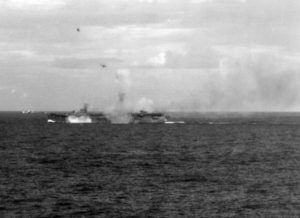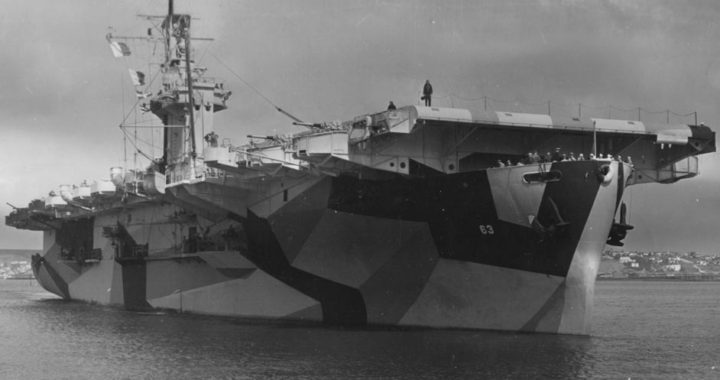At 10:53 am on Wednesday, Oct 25, 1944, an Imperial Japanese Navy Mitsubishi Zero fighter, believed to have been piloted by Lt. Yukio Seki, dove through a curtain of anti-aircraft fire to crash deliberately onto the flight deck of the U.S. Navy escort carrier, U.S.S. St. Lo.

Japanese planes attacking USS St.Lo, October 25, 1944
The crash, which ultimately sank the carrier, was the first kamikaze attack of the Pacific War, which is to say it was the first time that a modern military organization had sent members on a mission with no intention of their surviving.
Before that date, Japanese and allied pilots had occasionally crashed damaged aircraft into enemy targets. It is also likely that some Japanese pilots – overcome by the emotion of battle – had deliberately crashed undamaged planes onto allied ships. But unlike Lt. Seki and his fellow kamikazes, those pilots had acted on the spur of the moment. They had not been condemned to death by their own leaders.
The suicide attack that morning – and the thousands that would follow – were conducted by hastily organized Special Attack Units, and they represented a final desperate bid by the Japanese to stave off a devastating total defeat. The destruction of Japanese naval airpower at the Battle of the Philippine Sea in June 1944, and the capture of Saipan by U.S. forces in July, spelled doom for Japan. The U.S. now had island bases within bomber range of Tokyo and the Japanese Navy had no means left to defend the homeland.
It was clear to Japanese military leaders that Japan no longer had any hope of halting the American advance. Massive American superiority in naval forces, air forces, and technology combined with the near-total strangulation of the Japanese home islands by U.S. submarine operations made military victory impossible.
But Japanese leaders had always known that they would not be able to match the United States in war material or other resources. The great equalizers, they believed, would be the Japanese fighting spirit and self-discipline. Japan, they reasoned, could simply not be defeated by an undisciplined western power.
Now, in their hour of desperation, Japanese military leaders again called upon the Japanese fighting spirit, which had been honed by decades of strict rule by military juntas that had brutally enforced an ideology stressing loyalty and fealty and a super patriotism that required absolute obedience to family and nation. Japanese history, culture, and a generation of military rule created the conditions in which organized suicide attacks were proposed, debated, and approved as a last-ditch military effort to deter an invasion of the home islands by terrifying the Americans with the promise of millions of American casualties.
Far from wild-eyed fanatics, Japanese kamikaze pilots had been raised to believe that their duty to their families and to their country far superseded their personal desires. Survivors of a brutal military training regimen, these pilots saw themselves as the modern embodiments of the traditionally revered “failed hero,” who gives his life in a doomed cause.
The rest of the Pacific War would hinge on Japan’s further development of the kamikaze weapon and on the U.S. Navy’s dogged efforts to counter the suicide attacks.
As for the St. Lo, her destruction capped the most consequential five hours in U.S. Navy history.
From 6:35 am until 10:00 am that morning, St. Lo and five of her sister ships, accompanied by three destroyers and four destroyer escorts, had been chased across the waters of Leyte Gulf by an overwhelmingly powerful Japanese force of four battleships, six heavy cruisers, two light cruisers and eleven destroyers.
Through a combination of luck, good fortune, unrivaled courage, and Japanese miscalculations, the carrier group escaped annihilation, though at the cost of one thousand American sailors, an escort carrier, two destroyers, and a destroyer escort.
But St. Lo came through the fight virtually unscratched, even though Japanese warships had closed to within four miles of her during the chase. Shortly before 10:00 am the Japanese veered away and at 10:10 am the St. Lo secured from general quarters.
Having survived surface combat as one of the great underdogs of the Second World War, and not being exactly sure how they had done it, the crew of St. Lo had just a few minutes to consider their unlikely escape. At 10:51 am the exhausted sailors were called back to general quarters when Japanese planes were spotted less than a mile away. Two minutes later, the kamikaze struck St. Lo.
In the first moments after the kamikaze strike, St. Lo’s commanding officer, Captain Francis McKenna, thought that the damage was minor. The plane, approaching from astern, had smashed a small hole in the after portion of the wooden flight deck, but had not penetrated the deck and had careened the length of the ship, sliding right off the bow. The smoldering hole looked to be easily repaired.
But unknown to CAPT McKenna and the other officers on the carrier’s bridge, the Japanese plane had carried two bombs, at least one of which had penetrated the flight deck, starting a fire in the hangar bay below. Within a minute, a large explosion rocked the hangar and buckled a portion of the flight deck. That explosion was followed by as many as six other explosions over the next twenty-five minutes. Those blasts ripped open the flight deck, the hull, and, finally, the ship’s bottom. St Lo sank at 11:25 am, with a loss of 113 sailors. Around thirty more men died later of wounds.
The coordinated kamikaze attacks damaged three other escort carriers that day, but it was the destruction of the St. Lo, at the hands of a single Japanese pilot, that changed the direction of the Pacific War.
(Photo: By U.S. Navy – U.S. Navy National Museum of Naval Aviation photo No. 2000.236.017, Public Domain, https://commons.wikimedia.org/w/index.php?curid=17131102)
For more information on the creation and operations of the Special Attack Groups, see Danger’s Hour, by Maxwell Taylor Kennedy, published by Simon & Schuster Paperbacks, New York, 2008
October 25, 2018
Photo: USS St. Lo (CVE 63) US Navy photograph
